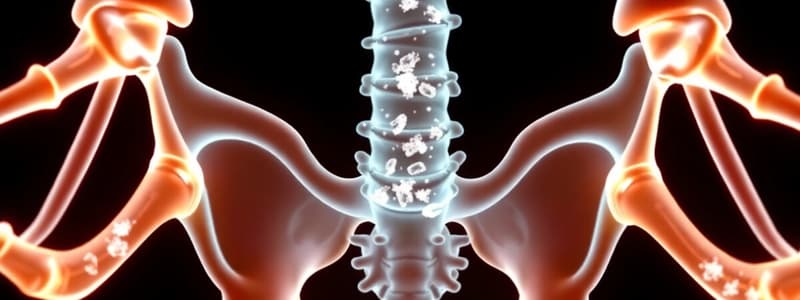Podcast
Questions and Answers
Welcher der folgenden Prozesse erzeugt einen violetten Farbkomplex mit Kresolphtalein?
Welcher der folgenden Prozesse erzeugt einen violetten Farbkomplex mit Kresolphtalein?
- Ionenselektive Elektrode
- Flammenfotometrie (correct)
- Atomabsorptionsfotometrie
- Atomemissionsfotometrie
Was ist der Referenzbereich für Calcium im Serum/Plasma (Heparin)?
Was ist der Referenzbereich für Calcium im Serum/Plasma (Heparin)?
- 2,00-2,15 mmol/l
- 2,20-2,65 mmol/l (correct)
- 3,00-3,50 mmol/l
- 1,50-1,85 mmol/l
Welche Erkrankungen können zu einer Hyperkalziämie führen?
Welche Erkrankungen können zu einer Hyperkalziämie führen?
- Vitamin D-Mangel
- Hyperparathyreoidismus (correct)
- Chronische Niereninsuffizienz
- Hypoparathyreoidismus
Welche Werte gelten als medizinischer Notfall bei Hyperkalziämie?
Welche Werte gelten als medizinischer Notfall bei Hyperkalziämie?
Welche Methode ist nicht zur Analyse von Calcium geeignet?
Welche Methode ist nicht zur Analyse von Calcium geeignet?
Welcher Referenzbereich wird für Magnesium im Serum/Plasma angegeben?
Welcher Referenzbereich wird für Magnesium im Serum/Plasma angegeben?
Welche der folgenden Symptome sind typisch für Hypermagnesiämie?
Welche der folgenden Symptome sind typisch für Hypermagnesiämie?
Was kann oft mit Hypomagnesiämie zusammen auftreten?
Was kann oft mit Hypomagnesiämie zusammen auftreten?
Was kann eine mögliche Ursache für Hypomagnesiämie sein?
Was kann eine mögliche Ursache für Hypomagnesiämie sein?
Was ist bei normalem Magnesiumwert im Blut zu beachten?
Was ist bei normalem Magnesiumwert im Blut zu beachten?
Welche der folgenden Funktionen hat das Knochensystem nicht?
Welche der folgenden Funktionen hat das Knochensystem nicht?
Welche Zellen sind nicht Teil des Knochenkompartiments?
Welche Zellen sind nicht Teil des Knochenkompartiments?
Welches Element ist nicht direkt Bestandteil des Knochenmineral
Welches Element ist nicht direkt Bestandteil des Knochenmineral
Welche der folgenden Substanzen ist kein Indikator der Stoffwechselaktivität der Knochenzellen?
Welche der folgenden Substanzen ist kein Indikator der Stoffwechselaktivität der Knochenzellen?
Welches der folgenden Elemente spielt keine zentrale Rolle bei der Blutgerinnung?
Welches der folgenden Elemente spielt keine zentrale Rolle bei der Blutgerinnung?
Welches der folgenden Probleme ist kein Ergebnis einer Pseudohyperkalziämie?
Welches der folgenden Probleme ist kein Ergebnis einer Pseudohyperkalziämie?
Welches Vitamin fördert die Erhöhung des Kalziumspiegels im Blut?
Welches Vitamin fördert die Erhöhung des Kalziumspiegels im Blut?
Bei welcher Methode wird Kalzium nicht gemessen?
Bei welcher Methode wird Kalzium nicht gemessen?
Welche Aufgabe hat Anorganisches Phosphat nicht?
Welche Aufgabe hat Anorganisches Phosphat nicht?
Welche der folgenden Erkrankungen können durch die Bestimmung von ACP identifiziert werden?
Welche der folgenden Erkrankungen können durch die Bestimmung von ACP identifiziert werden?
Welche Störfaktoren können die Ergebnisse des ACP-Tests beeinflussen?
Welche Störfaktoren können die Ergebnisse des ACP-Tests beeinflussen?
Wie wird die Kinetische Enzymaktivitätsmessung von ACP durchgeführt?
Wie wird die Kinetische Enzymaktivitätsmessung von ACP durchgeführt?
Welcher Referenzbereich gilt für die ACP-Bestimmung im Serum?
Welcher Referenzbereich gilt für die ACP-Bestimmung im Serum?
Welche Rolle spielt Magnesium im Körper?
Welche Rolle spielt Magnesium im Körper?
Welche Methode wird zur Bestimmung von Magnesium eingesetzt?
Welche Methode wird zur Bestimmung von Magnesium eingesetzt?
Welcher der folgenden Faktoren kann falsche hohe Werte bei der Magnesiumbestimmung vortäuschen?
Welcher der folgenden Faktoren kann falsche hohe Werte bei der Magnesiumbestimmung vortäuschen?
Wie wird (nPSP) bei der Bestimmung der nicht-prostataspezifischen SP ermittelt?
Wie wird (nPSP) bei der Bestimmung der nicht-prostataspezifischen SP ermittelt?
Was ist die Hauptfunktion der sauren Phosphatase (ACP) im Körper?
Was ist die Hauptfunktion der sauren Phosphatase (ACP) im Körper?
Welches der folgenden Elemente ist ein wichtiger Baustein von Knochen?
Welches der folgenden Elemente ist ein wichtiger Baustein von Knochen?
Welche Ursache kann zu einer Hypokalziämie führen?
Welche Ursache kann zu einer Hypokalziämie führen?
Was kann falsch hohe Werte bei der Phosphatanalyse vortäuschen?
Was kann falsch hohe Werte bei der Phosphatanalyse vortäuschen?
Welche Methode wird zur Bestimmung des anorganischen Phosphats verwendet?
Welche Methode wird zur Bestimmung des anorganischen Phosphats verwendet?
Was ist der Referenzbereich für Phosphor im Serum?
Was ist der Referenzbereich für Phosphor im Serum?
Welche Erkrankung ist typischerweise mit Hyperphosphatämie verbunden?
Welche Erkrankung ist typischerweise mit Hyperphosphatämie verbunden?
Was ist eine häufige Ursache für Hypophosphatämie?
Was ist eine häufige Ursache für Hypophosphatämie?
Welches Enzym ist für die Bestimmung der alkalischen Phosphatase verantwortlich?
Welches Enzym ist für die Bestimmung der alkalischen Phosphatase verantwortlich?
Was ist ein physiologischer Grund für eine Erhöhung der alkalischen Phosphatase?
Was ist ein physiologischer Grund für eine Erhöhung der alkalischen Phosphatase?
Was kann die Aktivität der alkalischen Phosphatase hemmen?
Was kann die Aktivität der alkalischen Phosphatase hemmen?
Für welche Erkrankungen ist ein Anstieg der alkalischen Phosphatase pathologisch?
Für welche Erkrankungen ist ein Anstieg der alkalischen Phosphatase pathologisch?
Welche Isoenzyme sind Formen der alkalischen Phosphatase?
Welche Isoenzyme sind Formen der alkalischen Phosphatase?
Wo findet man die saure Phosphatase hauptsächlich?
Wo findet man die saure Phosphatase hauptsächlich?
Was ist eine Hauptquelle für saure Phosphatase im Körper?
Was ist eine Hauptquelle für saure Phosphatase im Körper?
Welche Funktion hat die saure Phosphatase?
Welche Funktion hat die saure Phosphatase?
Flashcards
Bone functions
Bone functions
Support, protection, calcium/phosphate storage, and blood cell production.
Bone compartments
Bone compartments
Bone cells (osteoblasts, osteoclasts, blood cells), organic matrix (collagen, proteoglycans), and inorganic bone mineral (apatite).
Bone minerals
Bone minerals
Calcium and phosphate, which form the crystals (apatite) in bone.
Alkaline phosphatase
Alkaline phosphatase
Signup and view all the flashcards
Calcium's role
Calcium's role
Signup and view all the flashcards
Inorganic phosphate
Inorganic phosphate
Signup and view all the flashcards
Vitamin D (active form)
Vitamin D (active form)
Signup and view all the flashcards
Preventing Pseudohypo/hypercalcemia
Preventing Pseudohypo/hypercalcemia
Signup and view all the flashcards
Calcium measurement
Calcium measurement
Signup and view all the flashcards
Bone Cell types
Bone Cell types
Signup and view all the flashcards
Bone Matrix Organic components
Bone Matrix Organic components
Signup and view all the flashcards
Atomabsorptionsfotometrie
Atomabsorptionsfotometrie
Signup and view all the flashcards
Hyperkalziämie
Hyperkalziämie
Signup and view all the flashcards
Referenzbereich Ca
Referenzbereich Ca
Signup and view all the flashcards
Hyperparathyreoidismus
Hyperparathyreoidismus
Signup and view all the flashcards
Maligne Tumorerkrankungen
Maligne Tumorerkrankungen
Signup and view all the flashcards
Acid Phosphatase (ACP)
Acid Phosphatase (ACP)
Signup and view all the flashcards
Prostate-Specific Acid Phosphatase (PSP)
Prostate-Specific Acid Phosphatase (PSP)
Signup and view all the flashcards
ACP measurement
ACP measurement
Signup and view all the flashcards
Serum/Plasma ACP reference range
Serum/Plasma ACP reference range
Signup and view all the flashcards
Increased ACP causes
Increased ACP causes
Signup and view all the flashcards
Magnesium function
Magnesium function
Signup and view all the flashcards
Magnesium measurement interference
Magnesium measurement interference
Signup and view all the flashcards
Magnesium measurement method
Magnesium measurement method
Signup and view all the flashcards
Tartrate
Tartrate
Signup and view all the flashcards
Acid Phosphatase Interference
Acid Phosphatase Interference
Signup and view all the flashcards
Hypermagnesemia
Hypermagnesemia
Signup and view all the flashcards
Hypomagnesemia
Hypomagnesemia
Signup and view all the flashcards
Magnesium Reference Range
Magnesium Reference Range
Signup and view all the flashcards
Magnesium Values > 5 mmol/l
Magnesium Values > 5 mmol/l
Signup and view all the flashcards
Atomabsorptionsfotometrie
Atomabsorptionsfotometrie
Signup and view all the flashcards
Hypokalziämie
Hypokalziämie
Signup and view all the flashcards
Hyperphosphatämie
Hyperphosphatämie
Signup and view all the flashcards
Hypophosphatämie
Hypophosphatämie
Signup and view all the flashcards
Alkalische Phosphatase (ALP)
Alkalische Phosphatase (ALP)
Signup and view all the flashcards
Hämolyse & ALP
Hämolyse & ALP
Signup and view all the flashcards
Phosphatnachweis
Phosphatnachweis
Signup and view all the flashcards
Phosphor Referenzbereich
Phosphor Referenzbereich
Signup and view all the flashcards
ALP Referenzbereich
ALP Referenzbereich
Signup and view all the flashcards
Bestimmungsmethode Phosphat
Bestimmungsmethode Phosphat
Signup and view all the flashcards
ALP Bestimmung
ALP Bestimmung
Signup and view all the flashcards
Saure Phosphatase
Saure Phosphatase
Signup and view all the flashcards
Hypoparathyreoidismus
Hypoparathyreoidismus
Signup and view all the flashcards
Vitamin D-Mangel
Vitamin D-Mangel
Signup and view all the flashcards
Knochenerkrankungen
Knochenerkrankungen
Signup and view all the flashcards
Knochenmetastasen
Knochenmetastasen
Signup and view all the flashcards
Study Notes
Knochen- und Mineralstoffwechsel
- Knochen- und Mineralstoffwechsel sind wichtige Stoffwechselprozesse im Körper.
- Funktionen des Knochensystems:
- Stütz- und Schutzfunktion
- Kalzium- und Phosphatspeicher
- Ort der Blutbildung
- Zellen des Knochens:
- Osteoblasten
- Osteoklasten
- Blutbildende Zellen
- Organische Knochenmatrix (Kollagen, Proteoglykane)
- Knochenmineral (Apatit aus Kalzium und Phosphat)
- Klinisch chemische Kenngrößen des Knochenstoffwechsels:
- Kalzium
- Phosphat
- Substanzen der Stoffwechselaktivität der Knochenzellen/Enzyme (Alkalische Phosphatase, Saure Phosphatase)
- Kalzium:
- Bestandteil von Knochen und Zähnen
- Blutgerinnung
- Erregbarkeit von Nerven und Muskeln
- Anorganisches Phosphat:
- Bestandteil von Knochen, Zähnen, Haaren, Nägeln
- Energieträger (ATP)
- Zellteilung
- Puffersystem im Blut
- Regulation der Kalzium- und Phosphatkonzentration:
- Parathormon (PTH)
- Calcitonin
- Aktives Vitamin D (Calcitriol)
- Kalziumnachweis:
- Fotometrische Messung nach chemischer Umsetzung
- Flammenfotometrie
- Atomabsorptionsfotometrie
- Ionenselektive Elektrode
- Referenzbereich Serum/Plasma (Kalzium):
- 2,20-2,65 mmol/l
- Störungen des Knochenstoffwechsels:
- Hyperkalziämie (Werte > 3,75 mmol/l):
- Hyperparathyreoidismus
- Maligne Tumorerkrankungen
- Vitamin D-Überdosierung
- Hypokalziämie:
- Hypoparathyreoidismus
- Enteral und renal bedingt
- Vitamin D-Mangel
- Knochenbildende Tumoren
- Hyperkalziämie (Werte > 3,75 mmol/l):
- Störungen des Knochenstoffwechsels (Phosphat):
- Hyperphosphatämie
- Hypoparathyreoidismus
- Knochenmetastasen
- Phosphatnachweis:
- Hämolyse täuscht falsch hohe Werte vor
- Fotometrische Messung nach chemischer Umsetzung
- Molybdat/-än - Vanadat – Methode
- Referenzbereich Serum/Plasma (Phosphor):
- 0,84-1,45 mmol/l
- Störungen des Knochenstoffwechsels:
- Hypophosphatämie
- Hyperparathyreoidismus
- Vitamin D-Mangel
- Zuckerinfusionen
- Hämolyse, Auflösung der Muskelfasern
Enzyme
- Alkalische Phosphatase (AP):
- Isoenzyme: Leber-AP, Knoch-AP, Dünndarm-AP, Plazenta-AP
- Indikation: Leber- und Gallengangserkrankungen, Knochenerkrankungen
- Saure Phosphatase (ACP):
- Knochen, Prostata, Erythrozyten und Thrombozyten
- Tartrat-hemmbare SP (prostataspezifisch)
- Tartrat-resistente SP (vorwiegend Knochen)
- Indikation: Knochenerkrankungen, Prostatakrebs (PSA)
- ALP-Nachweis:
- Kinetische Enzymaktivitätsmessung
- p-Nitrophenylphosphat + H2O → Phosphat + p-Nitrophenol
- Referenzbereich Serum/Plasma (ALP):
- < 270 U/I
- Pathologie (ALP):
- Erhöhung der Alkalischen Phosphatase
- Physiologisch: Leber- und Gallenwegserkrankungen, Knochenerkrankungen, Tumoren und Metastasen
- Erhöhung der Alkalischen Phosphatase
Magnesium (Mg)
- Knochenbaustein
- Neuromuskuläre Erregung (Herz)
- Rolle in vielen Stoffwechselvorgängen
- Cofaktor vieler Enzymsysteme
- Bedeutsam intrazelluläres Kation
- Im Plasma: ionisiert, proteingebunden, komplexgebunden
- Mg-Nachweis:
- Fotometrische Messung nach chemischer Umsetzung
- Atomabsorptionsfotometrie
- Referenzbereich Serum/Plasma (Mg):
- 0,73 - 1,06 mmol/l
- Pathologie (Mg):
- Hypermagnesiämie:
- Medikamente und Infusionen
- Nierenversagen
- Symptome: verringerte Reflexe, Lähmungserscheinungen, Herzrhythmusstörungen
- Werte > 5 mmol/l: Atem- und Herzstillstand
- Hypomagnesiämie:
- Enteral und renal bedingt
- Endokrine Störungen
- Symptome: Muskelkrämpfe, Herzrhythmusstörungen
- Oft begleitet von Hypokalziämie und -kaliämie
- Hypermagnesiämie:
Studying That Suits You
Use AI to generate personalized quizzes and flashcards to suit your learning preferences.




